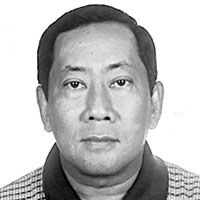Col. Manuel Segura: A great Cebuano hero

How time flies indeed! Today is the 72nd anniversary (it is Dec. 8 here) of the surprise attack by the Japanese Imperial Navy against the US Naval base in Hawaii called Pearl Harbor, which turned the already raging war in Europe against the Nazis into a global conflict, called World War II. This war resulted in at least 50 million casualties and in the Philippines at least 10% of the Filipino population died during that war.
If the anniversary of Pearl Harbor is already 72 years old, just imagine how old would our World War II Veterans be? Last Thursday, Nov. 28, my uncle, the elder brother of my mother, Col. Manuel Segura (Ret) died at the Asian Hospital at 94 years old. After a vigil in Quezon City, his remains arrived in Cebu City last Tuesday. Yesterday, his remains were brought to the Cebu City Hall because Mayor Michael Rama wanted to honor him.
Tio Manning as we fondly called him, was our local World War II hero in Cebu, having been with the guerrilla force under the Command of Col. James Cushing, a mining engineer who during the Japanese occupation was, President, Governor, Mayor, King or Chieftain of Cebu.
But more importantly, since no one in his guerrilla group wrote about the exploits of the Cebu guerrillas, in 1975 Col. Segura then wrote the book, entitled “Tabunan.â€Tabunan is the location of the headquarters of Col. Cushing called the Cebu Area Command (CAC) in Barangay Tabunan, the barrio on the border between Cebu City and the Municipality of Balamban, which faces Mt. Manunggal.
“Tabunan†gave Cebuanos an insight on the life of the guerrillas fighting in the mountain fastness of Cebu. Being his nephew, I have heard these exploits during family parties when my uncles would talk about the war. But then I thought that these were just plain stories. But reading his book triggered in me a profound interest in the history of Cebu. Then in 1992 Col. Segura came up with his second book entitled “The Koga Papers.†This was the book that made the Cebuano guerrillas world famous.
The Koga Papers is the story of Admiral Mineichi Koga who took over the command of the Japanese Combine Fleet from Pearl Harbor architect Isoroku Yamamoto whose plane was shot and crashed in Rabaul. Admiral Koga was moving his headquarters from Koror, Palau to Davao and took two Kawanishi Flyboats for the 600-mile trip. Koga took the first plane, while his Chief of Staff, Admiral Shigeru Fukudome was on the other seaplane carrying the Z-Plan, the final draft of the Combine Fleet Secret Operations for the final defense of Japan’s remaining assets in the Pacific.
But along the way, they ran into an unexpected typhoon and both planes strayed far from their original flight path. Koga’s plane disappeared, while Admiral Fukodome’s plane crash-landed off the town of San Fernando, 30 kilometers south of Cebu City. The survivors were captured by the guerrillas of Col. Cushing and brought to Tabunan. But the Z-Plan was found by guerrillas off Perelos, Carcar. They didn’t know what it was and so they sent it to Col. Cushing who found the documents of extreme importance.
Meanwhile, Col. Cushing had to let go of his prized hostage, Admiral Fukudome who was the highest Flag officer ever to be captured in the Pacific War because the Japanese Army in Cebu City threatened to kill Cebuano civilians if he refused. After Fukudome and his group were released, the Z-Plan was sent via a submarine, the USS Crevalle to the headquarters of Gen. Douglas MacArthur in Australia and after deciphering the Z-Plan, the plan to invade the Philippines was moved earlier from December to October and from General Santos City to Tacloban City. The rest is history.
It was indeed a great honor to be related to Col. Segura. From him, I learned the spirit of volunteerism. He was only 22 years old when the war broke out. Being an ROTC Cadet, he volunteered to fight the Japanese. My uncle also taught me about courage. Once he showed me his Japanese Katana aka Samurai sword. Then I asked him how he got it. He really didn’t want to go into details… he just told me, “I had to fight for my life to get this.†If you knew how the Japanese soldier would fight to the death… then it really took great courage to fight a Japanese, soldier man-to-man.
My uncle thought me about honesty and integrity. Being a soldier all his life, he was part of the Philippine Constabulary (PC) and was assigned as PC Chief of the Province of Bohol and later Negros Province. He told me stories about politicians wanting to use him during the elections, but he refused. This is the reason that despite his being a highly-decorated World War II hero, he retired in 1972 just before Martial Law was declared still with the rank of Colonel. Tomorrow Col. Segura will be buried with full military honors at high noon. But his memory will linger with us forever.
* * *
For email responses to this article, write to [email protected] or [email protected]. His columns can be accessed through www.philstar.com.
- Latest
- Trending





























